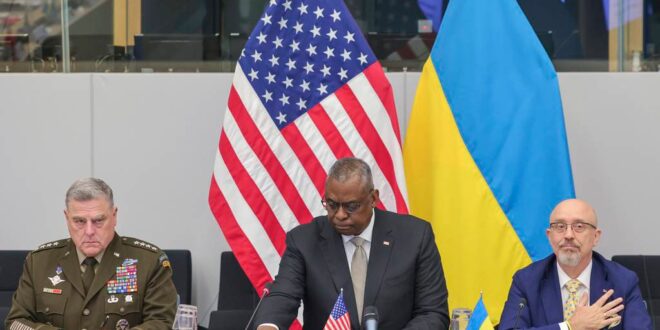Ukraine’s allies need to “chip in” to create a complex mix of air defenses as Russia bombards Ukraine’s cities and the civilians in them, America’s top military officer said Wednesday.
Joint Chiefs of Staff Chairman Gen. Mark Milley and U.S. Defense Secretary Lloyd Austin led a meeting of more than 50 countries in Brussels, where defense chiefs pledged to supply munitions for Ukraine’s air defenses. Even as Germany supplied its first IRIS-T air defense system to Ukraine, Pentagon officials highlighted the tough technical challenge ahead.
Ukrainian Defence Minister Oleksii Reznikov said air defense systems are the country’s “top priority” after Russia unleashed a spate of missile and drone attacks this week across the nation that reportedly targeted energy and civilian services, killing at least 19 people.
“The horrific and indiscriminate attacks against Ukrainian cities left civilians killed and civilian critical infrastructure destroyed,” NATO chief Jens Stoltenberg said Tuesday, according to media reports. “This demonstrates the urgent need for more air defense for Ukraine.”
In a news conference at NATO headquarters on Wednesday, Austin said the Ukraine Defense Contact Group discussed ways to increase training of Ukrainian forces, accountability measures of arms sent to Ukraine and the allied push to “galvanize our industrial bases to fire up production for the systems to defend Ukraine while meeting our own security needs.” He pointed to German and Danish investments in Slovakia’s howitzer production.
The spotlight was on Ukraine’s request for an integrated air and missile defense system, which Milley said allies would strive to fulfill. That would be made up of short-range, low-altitude systems; medium-range, medium-altitude systems; and long-range, high-altitude systems that together would neutralize the threat of Russian aircraft and missiles.
“What needs to be done here by all of the countries at the conference today is chip in and help them rebuild and sustain an integrated air and missile defense system, specifically old systems,” Milley said.
Ukraine has been using its Russian-made SA-6 and SA-8 air defenses to deny Russian forces air superiority and the ability to conduct combined arms maneuver. Now Ukraine is asking for Cold War-era Hawk systems ― a medium-range, medium-altitude system that Milley said is “an older system but it’s quite effective.”
Ukraine hopes to also receive donations of American-made Patriot systems, German systems and unnamed Israeli systems.
The undertaking would be complex. Disparate systems would have to be brought together, deployed, and made to communicate with radars and each other in order to acquire Russian targets ― and Ukrainian forces would have to be trained on it all, Milley said.
“So it’s quite complicated from a technical standpoint. It is achievable, and that’s what we’re aiming at,” he added.
The timing is an open question. When a Ukrainian reporter asked pointedly when the people of Ukraine “will be able to sleep well” and expressed concern about his family back home, Austin said the unpredictable nature of the conflict makes it hard to predict when it will be safe to travel in Ukraine.
Austin pointed to new pledges from the meeting for munitions for existing systems and Germany’s delivery of the first of four IRIS-T systems. IRIS-T is capable of defending against approaching missiles at an altitude of up to 20 kilometers (12 miles) and a distance of up to 40 kilometers (25 miles).
“I know that you’re concerned about your family,” Austin told the reporter, “and certainly that’s understandable. But we’re going to do everything we can, as fast as we can, to help the Ukrainian forces get the capability they need to protect the Ukrainian people. That’s very, very important to us.”
 Eurasia Press & News
Eurasia Press & News




